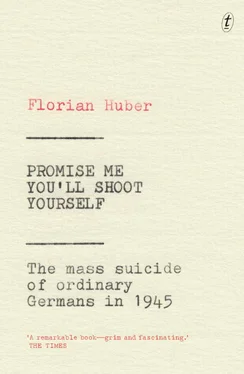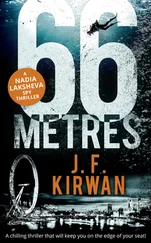From day one, the eastern campaign claimed an exceptional number of losses. While an average of 2100 Germans died daily, the death toll on the Soviet side—slain soldiers, starved POWs, murdered civilians—reached more than 14,100 a day. By the end of April 1945, at least twenty million Soviet nationals had lost their lives—at the hands of the Germans whose towns and villages the Red Army soldiers were now rolling through with their tanks. It is unlikely that the Russian soldiers were aware of the precise figures, but they all knew that the Germans had set out to herd them into slave camps or throw their bodies into pits. Each one of them had cause for revenge and retribution, for feelings of hatred and triumph. Many had lost loved ones, and what’s more, they had been fighting since 1941 without a single day’s leave. Now, after 1409 days of exterminatory war, they were on the point of victory, declaring: ‘The time has come to annihilate the fascist beast once and for all, so that it can never again threaten our homeland with a new war.’
• • •
Two hundred kilometres south of Demmin, the soldiers of the 1st Belorussian Front saw their goal near at hand when they stormed the Reichstag on the morning of 30 April. The Soviet commanders hoped to see the red hammer-and-sickle flag fluttering on the roof in time for the victory parade in Moscow on 1 May. Tanks, assault guns, howitzers and rocket launchers fired endless salvos at the Reichstag and into the government district, where about ten thousand people were congregated in small clusters. This motley crew at the heart of the Third Reich was all that remained of its former elite: grim defenders and despondent reservists, Waffen SS men, Hitler Youth boys and Volkssturm soldiers, government clerks and party representatives. Meanwhile, in a bunker deep down below the Reich Chancellery with his retinue, the Führer and Chancellor of the Reich, Adolf Hitler, was, in his own way, preparing for the final act.
The night before, mindful of posterity, he had dictated to his secretary a political and a private testament setting out his vision of the world—a vision he had repeatedly set out to his entourage over the years in endlessly circling monologues. The subjects are the same as ever: his struggle for peace, international Jewry’s responsibility for war and destruction, his own people’s betrayal. But the tone changes when he turns his attention to the imminent end of the Reich; suddenly his self-righteous litany is shot through with fear of the opponent’s revenge:
I do not, moreover, want to fall into the hands of enemies who are eager for a new Jewish-staged spectacle to amuse the hate-filled masses. For that reason, I have decided to remain in Berlin and to die by my own free will at such a time as I believe that the very position of Führer and Chancellor is no longer tenable.
Directly confronting the enemy, negotiating a ceasefire, perhaps even signing a capitulation—all that was inconceivable to Hitler. Surrendering himself to the victorious Soviets would have been at once the worst possible ignominy and a terrible punishment. Leaving the burning capital to become a prisoner of whatever kind in southern or western Germany was equally out of the question. It would never have entered his mind to answer for his twelve years as the leader of the German Reich before a judge, before the Allies, the world or his own people. Even less did it occur to him to face his conscience.
That left suicide. After a life of such extremes—from deepest humiliation to supreme power—there could be no alternative. A number of people had long predicted this move; in 1939, a German writer living in exile in London had called him ‘the potential suicide par excellence’. No one knew this better than Hitler himself, who had prepared for the eventuality that his plans might fail by indulging in self-destructive fantasies and researching various suicide methods, some of which he discussed openly. If he failed, there could be no carrying on—not for him, and not for his people either. Downfall had to be total. His political testament ends with a call to fight on in the knowledge ‘that the surrender of a territory or a city is impossible’. Hitler’s own suicide presupposed the annihilation of Germany. The longer he put off the former, the closer he came to the latter.
Few farewell performances have been so minutely documented as that staged on 30 April 1945 in Hitler’s bunker—those thirty rooms spread over two floors, five metres underground. We have the reminiscences of the telephone operator, the secretary, the adjutant, the chauffeur, the valet, the commander of the Berlin Defence Area, the captain lieutenant, the Reich youth leader, the staff sergeant—and each of these accounts points at a contradiction at the heart of this epochal event. In every one we see the Thousand Year Reich gutter out in a cramped, dank bunker—a setting vastly at odds with the bombastic nature of the regime. The rooms were crammed with an indiscriminate collection of occasional tables, armchairs and narrow sofas. The somewhat feeble attempt to liven up the cold grey of the bunker walls with rattan chairs and brightly coloured rugs only accentuated the atmosphere of gloom, and perhaps most oppressive of all was the oversized oil portrait of Frederick the Great, whose sad gaze dominated the Führer’s tiny study.
By the end of April 1945, Adolf Hitler had given up. His back was hunched, his face sallow, his eyes lacklustre, his arms trembling, his whole body slumped. And yet he remained the fulcrum of the last few square feet of unoccupied German territory. In the early hours of 30 April, he embarked on an extended leave-taking ceremony, shaking the hands of dozens of servants and guards, doctors and nurses, to thank them for their service. Some replied with the oft-repeated slogans of Treue , Endsieg— loyalty, final victory—and Heil . At about seven o’clock, Hitler received the last update from the commander of Berlin, predicting that the city would fall within twenty-four hours. While Soviet artillery fire sent shock wave after shock wave through the bunker, he conferred with his personal adjutant, Otto Günsche.
I don’t want the Russians to display my corpse in a panopticon. Günsche, I expressly order you once again to ensure that nothing of the kind can happen under any circumstance.
• • •
In Demmin, a magnificent spring day was dawning, bright and fresh and sunny. The Wehrmacht men were interested only in their own retreat. The military hospitals had been evacuated, the depots and warehouses cleared or looted. Most of the remaining soldiers were on the far side of the old town, on the west bank of the Peene. ‘Didn’t sleep all night—how many does that make it?’ Gustav Skibbe noted in his journal. He could feel the front closing in, like an immense force hurtling towards him, a dark wave of pressure and noise.
Two days before, after weeks of calm, his unit had been ordered to up sticks, and now the soldiers were in a frenzy of activity, coming and going, running and shouting. Skibbe was glad of any assignment that allowed him to use his new vehicle.
At daybreak, he was rolling along the country road. He crossed Meyenkrebs Bridge over the Peene on the northern edge of town and drove a few miles through the marshland of the Trebel Valley, past farmsteads and squat houses and the village church of Wotenick to the town of Nossendorf. What a relief it was to feel the wind on his face after the atmosphere of panic and despair that had filled Demmin. In Nossendorf, he stocked up on fuel for the forthcoming retreat towards Dargun and Rostock. No one knew where they would end up. There were no longer clear destinations—only stops on the escape route. But the only way Skibbe could get onto the main road west was to drive all the way back and over the two bridges that had just been made ready to dynamite.
Читать дальше












